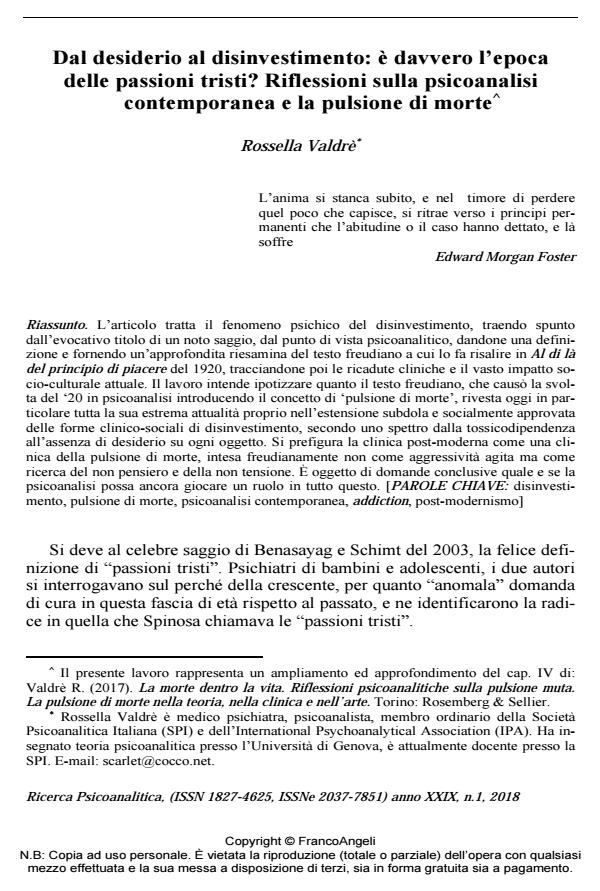From desire to decathexis: are we really in a period of sad passions? Reflections on today’s psychoanalysis and the death drive
Journal title RICERCA PSICOANALITICA
Author/s Rossella Valdrè
Publishing Year 2018 Issue 2018/1
Language Italian Pages 21 P. 41-61 File size 238 KB
DOI 10.3280/RPR2018-001005
DOI is like a bar code for intellectual property: to have more infomation
click here
Below, you can see the article first page
If you want to buy this article in PDF format, you can do it, following the instructions to buy download credits

FrancoAngeli is member of Publishers International Linking Association, Inc (PILA), a not-for-profit association which run the CrossRef service enabling links to and from online scholarly content.
Abstract: The article describes the psychic phenomenon of decathexis starting from the title of a well know essay, giving a psychoanalytical definition and reexamining Freud’s essay Beyond the Pleasure Principle (1920) tracing its clinical consequences and widespread social and cultural impact. This article intends to stress the importance of the essay that caused the shift of psychoanalysis with the introduction of the concept of death drive. The essay is especially well suited today to explain the subtle and socially approved extension of the clinical-social forms of decathexis that go from drug addiction to the absence of desire for anything. The post-modern clinic is a clinic of the death drive, seen as Freud did not as acted out aggression but as search for non-thought and non-tension. The article closes reflecting on the ability of psychoanalysis to play a role in this situation.
Keywords: Decathexis, death drive, contemporary psychoanalysis, addiction, post-modernism
- Ameisen J.C. La sculpture du vivant. Le suicide cellulaire ou la mort créatrice. Paris: Editions du Seuil (trad. it.: Al cuore della vita. Milano: Feltrinelli, 2011.
- Ambrosiano L. (2016). Relazione presentata al XVIII Congresso Nazionale SPI, Roma, maggio.
- Arendt H. (1963). La banalità del male. Eichmann a Gerusalemme. Milano: Feltrinelli, 1964.
- Assoun P.L. (1993). Freud et les sciences sociales. Psychanalyse et théorie de la culture. Paris: Armand Colin (trad. it. Freud e le scienze sociali. Psicoanalisi e teoria della cultura. Roma: Borla, 1999).
- Baranger W., Baranger M. (2011). La situazione analitica come campo bipersonale. Milano: Cortina.
- Baudrillard J. (1983). Les stratégies fatales,. Paris: Grasset & Frasquelle (trad. it.: Le strategie fatali. Milano: Feltrinelli, 2001).
- Bell D. (2009). Is Truth an Illusion? Psychoanalysis and postmodernism. International Journal of Pyshcoanalysis, 90: 331-345.
- Bellow S. (1983). On John Cheever. Discorso in occasione della morte di Cheever. New York Review of Books, 17 febbraio.
- Benasayag M., Schimt G. (2003): Las pasiones tristes. Sufrimiento pisquico y crisis social. Buenos Aires: Siglo XXI (trad. it.: L’epoca delle passioni tristi. Milano: Feltrinelli, 2004).
- Bolognini S. (2008). Super-Io fisiologico e le sue vicissitudini contemporanee. Psiche, 2: 69-78.
- Broder M. (2016). So Sad Today: Personal Essays. New York: Gran Central Publishing.
- Conrotto F. (2004). La sublimazione nella cura e nella teoria. Rivista di Psicoanalisi, 4: 1027-1048.
- Conrotto F. (2012). Forme espressive della psicopatologia nelle società postmoderne. Notes. Trasformazioni sociali e forme della psicoanalisi, 0: 35-43.
- De M’Uzan M. (1970): Le meme et l’identique. Revue française de Psychanalyse, 3: 441-453.
- Derrida J. (2003). Stati canaglia. Milano: Raffaello Cortina.
- Freud S. Opere di Sigmund Freud. Torino: Bollati Boringhieri.
- - (1894). Le neuro-psicosi di difesa, Vol. II.
- - (1915). Introduzione alla psicoanalisi, Vol. VIII.
- - (1917). Lutto e melanconia, Vol VIII.
- - (1920). Al di là del principio di piacere, Vol. IX.
- - (1923). L’Io e l’Es, Vol. IX.
- - (1929). Il disagio della civiltà, Vol. X.
- - (1932). Perché la guerra?, Vo.l XI.
- - (1937). Analisi terminabile e interminabile, Vol. XI.
- Green A. (1983). Narcissisme de vie, narcissme de mort. Paris: Editions de Minuit (trad. it.: Narcisismo di vita, narcisismo di morte. Roma: Borla,1985).
- Green A. (2010): Illusion et désillusions du travail psychanalytique, Paris: Odile Jacob (trad. it.: Illusioni e disillusioni nel lavoro psicoanalitico. Milano: Cortina, 2011).
- Hobsbawm E. (1994): Age of Extremes. The Short Twentienth Century 1914-1991. The Short Twentienth Century. UK: Penguin Group (trad. it.: Il Secolo breve 1914-1991:l’era dei grandi cataclismi. Milano: Rizzoli, 1997).
- Houellebecq M. (1997). Rester vivant (trad. it.: Restare vivi. La ricerca della felicità. Milano: Bompiani, 2008).
- Kaës R. (2005): Il disagio del mondo moderno e la sofferenza del nostro tempo. Psiche, 2: 57-71.
- Kertéz I. (2007). Il secolo infelice. Milano: Bompiani.
- Kristeva J. (2005). L’impudence d’énoncer, le langage maternell. Revue française de Psychanalyse, 69: 1655-1667.
- Lacan J. (1966). Ecrits. Paris: Edition du Seuil.
- Lacan J. (1985). Il Seminario, Libro III. Torino: Einaudi.
- Recalcati M. (2010): L’uomo senza inconscio. Milano: Raffaello Cortina.
- Schimdt-Hellerau C. (2000): Pulsion de vie, pulsion de mort. Libido et Lèthé. Paris: Delachaux et Niestlè.
- Séchaud E. (2005): Perdre, sublimer… .Revue française de Psychanalyse, 69: 1309-1379
- Valdrè R. (2015): Sulla sublimazione: un percorso del destino del desiderio nella teoria e nella cura. Milano: Mimesis.
- Wallace D.F. (1996). Infinite Jest. Boston, Massachussets: Little, Brown and Company.
- Zizek S. (2006a): How to read Lacan. London: Granta Publications (trad. it.: Come leggere Lacan. Guida perversa al vivere contemporaneo. Torino: Boringhieri, 2009).
- Zizek S. (2006b): Zizek e l’immaginario. In Carmarola F., a cura di, Il consumo delle immagini. Estetica e beni simbolici nella fiction economy. Milano: Mondadori.
Rossella Valdrè, Dal desiderio al disinvestimento: è davvero l’epoca delle passioni tristi? Riflessioni sulla psicoanalisi contemporanea e la pulsione di morte in "RICERCA PSICOANALITICA" 1/2018, pp 41-61, DOI: 10.3280/RPR2018-001005